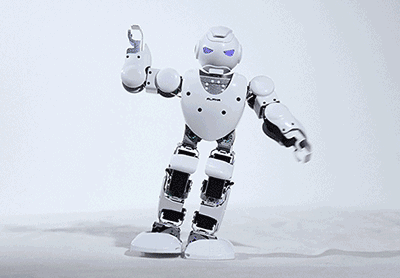The research on robots has made significant progress, and theoretically, all mechanical labor can be replaced by robots. From the increasingly mature industrial robots and mobile robots, it seems we are witnessing a historical repetition that once occurred in computer systems: transitioning from mainframes to workstations, and now to personal computers and handheld devices. In the past, robots were bulky and expensive, controlled by large computers that were difficult to move, often connected by cables. Today, we can build our small robots using numerous actuators and sensors controlled by inexpensive, compact onboard embedded computer systems.

Robots are products of interdisciplinary integration, and the breadth of knowledge involved is unprecedented. The disciplines spancomputer science, information technology, automatic control, electrical engineering, materials, mechanical engineering… Robotics engineers need a solid theoretical foundation and strong hands-on practical skills, with a high technical threshold, which is the direction for future development.
In 2017, when I first took the graduate entrance exam, I became particularly interested in this field. At that time, I searched various websites, but the information I collected was fragmented. So here, I will combine the courses I learned during my graduate studies at Beihang University and my own understanding to tell you what skills and knowledge you need to master to become a robotics engineer.


Mathematical methods permeate and govern all branches of natural science theory — von Neumann

If you have always held the view that “mathematics is a strange theory of a bunch of formulas and proofs, which is useless except for giving you a headache and preparing for exams,” then these two books“What is Mathematics” and “The Beauty of Mathematics” might change your mind. The former is referred to by netizens as the “book of preaching,” providing a profound and vivid explanation of the basic concepts and methods in the entire field of mathematics. The latter explains the application of mathematics in the IT industry, analyzing obscure concepts in an accessible manner, requiring you to have some foundational knowledge ofadvanced mathematics and probability theory.
Of course, in the field of robotics, the most important mathematical tool islinear algebra. Based on this, the main research content ofrotation representations, D-H modeling, Lie groups and Lie algebras, and quaternions forms the mathematical foundation of robotics, ultimately used to describe the state of rigid bodies in three-dimensional space.
To study the forces and motions of robots, you need to learn theoretical mechanics. To analyze the structural strength of materials and prevent damage to load-bearing components during robot operation, you need to learn materials mechanics. If using hydraulic or pneumatic devices as power sources, you need to understand some knowledge of fluid mechanics..
Just like annual buzzwords, common mathematical buzzwords in the field of robotics include:least squares, Kalman filtering, Fourier transforms, which are all challenging to understand, yet very useful, and worth your effort to study.
Least squares can perform curve fitting on data collected by sensors to obtain maximum likelihood estimates and are widely used in modern control. The Kalman filter is an optimal recursive data processing algorithm that has been widely applied for over 30 years, including in robot navigation, control, sensor data fusion, and even in military radar systems and missile tracking. In recent years, it has also been applied in computer image processing, such as facial recognition, image segmentation, and edge detection.Fourier analysis is not just a mathematical tool; it is a way of thinking that can completely overturn a person’s previous worldview. It is the channel connecting time domain space and frequency domain space, making many problems that are difficult to handle in the time domain so simple in the frequency domain. It is the theoretical foundation of modern communications; without its emergence, all communication devices would become a pile of scrap metal, losing their original function. In digital image processing, it can convert spatial domain pixels into the frequency domain, achieving unexpected results such as denoising, smoothing, and sharpening through simple filtering techniques.
A reliable mechanical structure is the foundation for robot operation. The most common mechanisms includelinkages, gears, cams, pulleys, etc. If you are a mechanical engineering student, you should be familiar with these; if you are a student from another major, you should also understand their characteristics and working principles. A frequently used structure in robots is the ball screw, which can convert rotary motion into linear motion.The inverted pendulum model plays a crucial role in the mechanical structure of robots and is widely used in bipedal robots (humanoid robots), quadrupedal robots (robot dogs), and other walking robots. After understanding its principles, you can try to simulate it using Matlab.
One easily overlooked point is the use of screws, bolts, and studs. You should be familiar with the types of screws and their characteristics. You need to refer to “Mechanical Design Handbook,” which can be considered the “Bible” of mechanical engineering, encompassing almost all knowledge about mechanics.
You need to learn SolidWorks to create 3D models, and learn AutoCAD to draw corresponding 2D drawings, facilitating later manufacturing. Use Adams to perform motion analysis on the mechanisms you design to demonstrate their feasibility and rationality. Utilize finite element analysis software such as Ansys or Abaqus to analyze the stress and deformation of structural components.
After completing the structural design, you enter the manufacturing stage. Mechanical manufacturing is divided into two types: subtractive manufacturing and additive manufacturing. Traditional mechanical manufacturing processes such as turning, milling, planing, grinding, and filing are typical of subtractive manufacturing. Nowadays, these processes are becoming increasingly convenient; you can hand over the drawings to a universal vendor for processing, or even purchase a desktop lathe, significantly reducing the manufacturing cycle. For beginners in robotics, use standard components whenever possible and purchase ready-made parts instead of manufacturing them yourself. This may sacrifice some weight and volume indicators, but it will increase the stability of machine operation and avoid unnecessary troubles.
In recent years, the emerging 3D printing belongs to additive manufacturing. Compared to subtractive methods, it can produce diverse and complex structures, especially suitable for personal customization. However, due to strength issues, its use is somewhat limited. It is often used to create prototype models during the verification phase of robotic principles.
Motors and pneumatic systems are the most common actuators in robots. For beginners, the main type used is DC motors. This includes ordinary DC motors, servos, and stepper motors. If conditions allow, you can try using AC motors and linear motors.
In DC motors, two technologies to understand are H-bridge and Pulse Width Modulation (PWM), the former is used to control the forward and reverse rotation of the motor, while the latter achieves speed control by changing the pulse width. A simple driver L298N is based on the H-bridge principle to provide motors with voltages higher than the signal (3.3v or 5v).
There are too many sensors available for robot design, so many that it would take days to discuss them all. Most books and materials introduce sensors by categorizing them according to their uses. However, this leads to a problem: you can never comprehensively introduce them. Therefore, I will categorize sensors based on their output signals, focusing on the interface between the sensor and the controller rather than the internal structure of the sensor itself. This way, when you encounter a new sensor, you can quickly locate its category and achieve engineering applications without fully understanding its working principle.
Common sensor output signals:
-
Binary signals (0 or 1):tactile sensors, switches (yes, a switch is also a type of sensor, very useful in limit situations)
-
Analog signals:microphones
-
Digital signals:attitude sensors
-
Pulse signals:encoders
-
Serial connection (RS232 or USB): Most sensors
-
Parallel connection:cameras
The core part of embedded systems is the microcontroller. Currently popular ones includeSTM32, Arduino, and Raspberry Pi, etc. Beginners are advised to start with Arduino, which encapsulates various functions, and you can check the definitions and usage of various functions on the official website. You can purchase STM32 from Taobao’s ZD atom for learning, which comes with learning materials; manually configuring the project can be troublesome, so you can use CubeMX to generate a project template, and then use Keil for program modification. Raspberry Pi runs the Linux Raspbian system, functioning more like a small PC, suitable for handling larger data volumes.
Learning about computer operation principles will deepen your understanding of microcontrollers. I recommend “Coding”, which requires minimal foundational knowledge and is generally understandable. This book starts with logic gates (AND, OR, NOT, XOR) and guides you step by step to registers, memory, arithmetic logic units, and central processing units. Theoretically, you could use the knowledge from this book to create a computer from scratch.
In information processing, you need to understand basic communication protocols such as serial UART, SPI, I2C, CAN bus, and RS232. To achieve wireless transmission, you should understand WiFi, Bluetooth, Zigbee, and learn how to configure network cables, as well as study TCP/IP, for which you can refer to “TCP/IP Illustrated”.
Once you are familiar with microcontrollers, you can learn about digital circuits (logical circuits, flip-flops, oscillating circuits, and analog-to-digital conversion) and some basic components (resistors and potentiometers, transistors, capacitors, MEMS). With this knowledge, you can use Altium Designer to draw circuit diagrams and create your own boards.
In traditional automation fields, you need to understand common control algorithms such as PID control, switch control, displacement control, speed control, force control, and multi-motor linear driving, etc. By abstracting the actual physical model, you can obtain the transfer function, and using Bode plots and root locus to analyze the transfer function is the main research content of automatic control.
In robot control, the most widely used programming language is C++. I recommend a comprehensive introductory book “C++ Prime Plus (Chinese Version)”. This book is quite thick; if you, like me, lack patience, you can download the English version and, when working on specific projects, directly search for keywords to find the corresponding chapters and fill in the gaps.
When you have a good grasp of C++, you can expand your knowledge of STL (Standard Template Library), as the functions that come with containers can greatly simplify your code.
In the Windows environment, compilation is generally done using Microsoft’s developed IDE: Visual Studio. In the Linux environment, earlier versions used Makefile to compile and run C and C++ files directly; now, CmakeLists is used to generate Makefile files for subsequent compilation using simple commands like add_executable (add executable file), add_library (add library), target_link_libraries (link library), etc.
Besides programming languages, understanding operating systems is also essential. I recommend the book Operating System, focusing on the three main characteristics of operating systems: virtualization, concurrency, and persistence. Pay special attention to learning some commands in the Linux terminal and how to use the Vim editor. There are many distributions of Linux, but for robotics, you should definitely choose Ubuntu, as the commonly used ROS tools (as of December 2019) are only available on Ubuntu.
If you are interested in artificial intelligence, two must-read books are Professor Zhou Zhihua’s “Machine Learning” and Ian Goodfellow’s Deep Learning. If you are interested in image processing, you can start by learning OpenCV to understand the principles behind it.
The mature applications in the field of robotics currently focus on the following three areas:robotic arms, mobile robots, and rotary aircraft. These robotic systems can be analyzed using the knowledge mentioned above, but due to space limitations, I won’t go into detail here.
